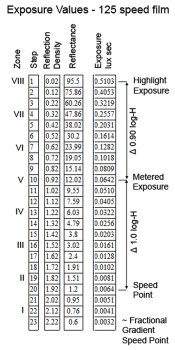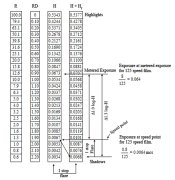Stephen Benskin
Member
The relationship between the metered exposure point and the speed point is different with the Zone System and the ISO B&W speed standard. Zone System is 1.30 logs and ISO is 1.0. This is the primary cause for the general EI discrepancy seen between the two methods.
Hg = P * shutter speed. P = ~8 lxs (also known as K1 in the meter calibration equation). For a 125 speed film Hg = 8/125 = 0.064 lxs. Speed point equation is 0.8/Hm. For 125 speed film, Hm is 0.8/125 = 0.0064 lxs. For a 125 speed film, Hg = 0.064 and Hm = 0.0064 or 10x or 1.0 log-H difference between Hg and Hm.
Here is an example of where 12% reflectance falls in relationship to the subject luminance range and the camera's illuminance range with one stop flare. Please note that the diffused highlight is considered 100% reflectance. For the record, the statistical average luminance range is 2.20 logs (7 1/3 stops).
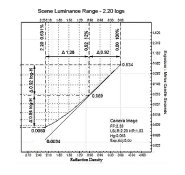
Here are two pages dealing with middle gray from the thread "Is the K factor relevant to me or should I cancel it out?"
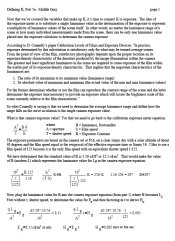
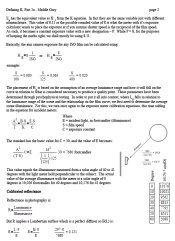
Hg = P * shutter speed. P = ~8 lxs (also known as K1 in the meter calibration equation). For a 125 speed film Hg = 8/125 = 0.064 lxs. Speed point equation is 0.8/Hm. For 125 speed film, Hm is 0.8/125 = 0.0064 lxs. For a 125 speed film, Hg = 0.064 and Hm = 0.0064 or 10x or 1.0 log-H difference between Hg and Hm.
Here is an example of where 12% reflectance falls in relationship to the subject luminance range and the camera's illuminance range with one stop flare. Please note that the diffused highlight is considered 100% reflectance. For the record, the statistical average luminance range is 2.20 logs (7 1/3 stops).

Here are two pages dealing with middle gray from the thread "Is the K factor relevant to me or should I cancel it out?"




